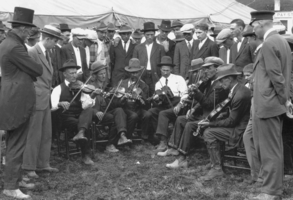 | Back to e-WV
| Back to e-WV
 The West Virginia Encyclopedia
The West Virginia Encyclopedia
 | Back to e-WV
| Back to e-WV
 The West Virginia Encyclopedia
The West Virginia Encyclopedia

The tradition of playing the fiddle in all probability came to our mountains with settlers from the British Isles. Since then, West Virginia has produced some of the finest fiddlers in the nation, and continues to do so.
The overwhelming majority of fiddlers in West Virginia are unknown to the public stage. They play for their own enjoyment or for the entertainment of family and friends. It was not until recent times, with the birth and growth of traditional music festivals, that some fiddlers became widely known. For many years the West Virginia State Folk Festival in Glenville was about the only place that provided a venue for true mountain fiddlers. It was there that the Carpenters from Clay and Braxton counties were discovered. French Carpenter, who surfaced at Glenville in the late 1950s, became nationally known in traditional music circles.
West Virginia’s best and most famous fiddler, Clark Kessinger, enjoyed a professional career in his youth, and was rediscovered in the late 1960s when he won the contest at the huge Union Grove festival in North Carolina. Braxton County’s Melvin Wine enjoyed a national reputation for most of the last half of the 20th century, winning the prestigious National Heritage Fellowship of the National Endowment for the Arts.
Fiddle contests are probably older than West Virginia, but there is not much documented history on the subject. There is evidence that many county fairs featured such contests at one time, and there is oral evidence that they were common at rural social events.
During the last half of the 20th century, they became a staple at festivals in many rural West Virginia communities, as well as at the state’s larger festivals. Many times the contests are divided into age categories, to allow for the declining dexterity of aging fiddlers. And while the junior divisions often provide the audience with some outstanding fiddling, it is the senior divisions that are more competitive and colorful.
One of the most intensive and competitive fiddle contests in our state has always been at the Glenville festival, even though the only prize is a blue ribbon. Clay County’s Lee Triplett and Ira Mullins carried on a lifetime rivalry at Glenville, to the delight of the festival audience.
Many people still confuse commercial or Nashville-type fiddling with the less-known traditional fiddling. But once a listener is exposed to Clay County’s Wilson Douglas playing ‘‘Yew Piney Mountain’’ or ‘‘Shelvin’ Rock,’’ or hears the music of the Hammons family from Pocahontas County, the difference becomes very obvious. And when it comes to the hard-driving fiddle needed for traditional square dancing, West Virginia fiddlers are unequaled.
The old mountain fiddlers did not always tune the fiddle to the violin tuning of E, A, D, G. They would often cross-tune to E,A, E,A, or D,G, D,G, or several other varieties. Such tuning gave the fiddle a different sound and allowed for a ‘drone’ lick or a bagpipe sound. They would also often vary from the traditional 16 counts to a section and add a couple of drag licks on the end of the line. While the Nashville or modern fiddler is predictable, the old mountain fiddler was not. His fiddling did not have to fit into any particular pattern and usually didn’t.
For years music scholars have argued that traditional fiddling would die as the old fiddlers passed from the scene. But the tradition goes on. A fine crop of young fiddlers is on the scene in the 21st century. Competition for the blue ribbons at the annual Vandalia Gathering in Charleston and the West Virginia State Folk Festival is as keen as ever.
Written by Mack Samples
Milnes, Gerald. Play of a Fiddle. Lexington: University Press of Kentucky, 1999.